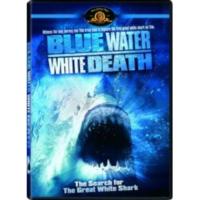
Talk about an oldie. This is probably the first commercial shark documentary shot for an audience. Peter Gimbel, who was one of the first to dive and film the Andrea Doria decided that he wanted to get a crew together and go out to film Great White Sharks in nature. Back in 1969 when they filmed this 1971 release, there was no where near the level of knowledge we have today about sharks in general and the Great White in particular. They weren’t even sure where to go to find them. Most of the film is spent looking, unsuccessfully for Great Whites. It’s not wasted because there is some marvelous underwater photography along the way.
They started the trip by following a whaling fleet out of Durban South Africa because they’d been told that White Sharks could strip a Sperm Whale in hours. OOPS, Oceanic White Tips, not Great Whites. But the footage is awesome. The video of the whalers in action both at sea and at the whaling station where the carcases were processed was
pretty much allowed to speak for itself. It was obvious that the hunting methods affected the crew as they watched. It didn’t stop them from looking for their own goal however. There are several dives where there are obviously dozens if not more Oceanic Whitetips in the water feeding on Sperm Whale carcases floating and waiting for recovery
by the whalers. The footage frome the cages is great, but even today, jaded by Shark Week and such on Discovery and Animal Planet etc, when they got out of the cages and filmed inside that swarm, I get a chill down my spine. There is also a demonstration of a powerhead in action (20 gauge shotgun shell in a short staff) when a shark got to close for
comfort for the divers. I didn’t see any of the threat behaviors that we’ve been taught about with sharks but back then, they didn’t know about them.
Another sequence involved the ship tying up to the HMS Hermes, a British Aircraft Carrier sunk by the Japanese during WWII in the Indian Ocean. She is lying in 170 feet of water. Apparently there is another diveable carrier out there. But she is pretty remote. There was a bit of drama on one of these dives when Peter Gimbel got bent. It was deffinately a different standard then as compared to now. He chose to decompress on the line rather than use the chamber they had on the expedition ship. Not only that, he surfaced and then went back down. So many no nos that we get told not to do almost 40 years later.
They finally headed to Dangerous Reef off of Australia and hired Rodney Fox as dive coordinator and actually shot a couple of Whites for the last 20 minutes of the film. One, a 16 footer, nearly isassembled one of the shark cages when he got caught up in the rope holding the bait before the photographer in the cage managed to cut it loose.
First he tried to fend the shark off with his dive knife. He says it was razor sharp and with a full strength thrust he barely got it an 8th of an inch into the sharks snout. At that point he decided that cutting the rope was a better idea.
This one is well worth watching.